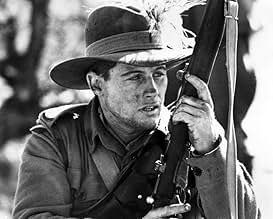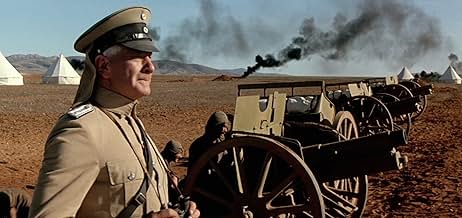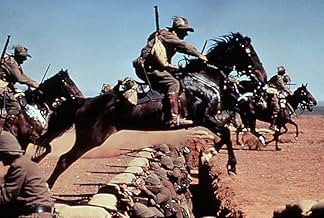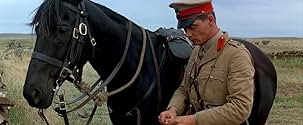AVALIAÇÃO DA IMDb
6,8/10
2,2 mil
SUA AVALIAÇÃO
Adicionar um enredo no seu idiomaIn 1917 when the British forces are bogged down in front of the Turkish and German lines in Palestine they rely on the Australian light horse regiment to break the deadlock.In 1917 when the British forces are bogged down in front of the Turkish and German lines in Palestine they rely on the Australian light horse regiment to break the deadlock.In 1917 when the British forces are bogged down in front of the Turkish and German lines in Palestine they rely on the Australian light horse regiment to break the deadlock.
- Direção
- Roteirista
- Artistas
- Prêmios
- 2 vitórias e 1 indicação no total
Jack Heywood
- Dave's Dad
- (as John Heywood)
Avaliações em destaque
This is an excellent film with surely the finest cavalry charge ever filmed. In this movie the horse is King and the care taken to illustrate the vital interaction between these magnificent animals and their riders is great to behold. The acting and direction are good without the need for big names. It has had a number of releases, the best being a 2.35 wide screen laser disc version in the USA. Australia has released a DVD version but it is dreadfully truncated being cut to 1.78 from the vastly more meaningful aspect ratio of the laser disc. On the big screen this film makes a fantastic impact and every effort should be made to see the original wide screen version in this way. Highly recommended.
I have watched this movie at least five times. Initially, I was a little disappointed by the tedium of the first half of the movie. I began to realize, however, that the first half of the movie is a pretty good reflection of military life prior to the second half of the 20th century: long periods of boredom and routine punctuated by major confrontations.
I've noticed that a few reviewers have remarked on the final "cavalry charge," which suggests to me that they really weren't paying much attention to the movie. The final charge on the Turkish positions is so much more awe-inspiring given the usual tactics of the Lighthorsemen. One of the most thrilling moments is when the Aussies prepare to meet the enemy on horseback and, instead of pulling out the classic cavalrymen's sabers, draw their bayonets for the charge. You almost want to laugh at the sight of 16" knives against the well-emplaced Turks.
This is one of the few war movies based on actual events that is fairly accurate, too. Take a look at some of the sites dedicated to the 4th Light Horse Briagde and you will see what I mean. A letter from one of the actual participants to his brother is an almost perfect description of the events as shown in the movie.
**** out of ***** if only for the charge
I've noticed that a few reviewers have remarked on the final "cavalry charge," which suggests to me that they really weren't paying much attention to the movie. The final charge on the Turkish positions is so much more awe-inspiring given the usual tactics of the Lighthorsemen. One of the most thrilling moments is when the Aussies prepare to meet the enemy on horseback and, instead of pulling out the classic cavalrymen's sabers, draw their bayonets for the charge. You almost want to laugh at the sight of 16" knives against the well-emplaced Turks.
This is one of the few war movies based on actual events that is fairly accurate, too. Take a look at some of the sites dedicated to the 4th Light Horse Briagde and you will see what I mean. A letter from one of the actual participants to his brother is an almost perfect description of the events as shown in the movie.
**** out of ***** if only for the charge
This colossal 1987 production - believe it or not - from RKO PICTURES is an Australian film closely resembling LAWRENCE OF ARABIA in its intent and rightly compared to ZULU. With a huge cast of Oz actors and directed by PHAR LAP (look it up) warhorse Simon Wincer it is basically about the last massive charge in the Middle East desert during World War One....an event still on the yearly Australian military forces roster of "Anzac" celebrations. Many other comments on this site will give you details of the history of the event and rightly applaud this lavish spectacular film. RKO Pictures had reformed with some co financing in the 80s and this is one of their few productions. BEST LITTLE WHOREHOUSE and THE BORDER are two others that spring to mind produced with Universal Pictures. With a $7 million budget and all of it on screen THE LIGHTHORSE became the last of the truly international films from Australia in the 80s. Others of this time are GALLIPOLI and CAREFUL HE MIGHT HEAR YOU and THE MAN FROM SNOWY RIVER and WE OF THE NEVER NEVER...each are films made with a lavish widescreen cinema release in mind and each huge Oz successes. THE LIGHTHORSEMEN is well worth the 140 minutes or so of carefully paced storytelling, all laced with Aussie humor and superb design and photography. The charge in the last two reels is truly breathtaking and on a cinema screen was particularly overwhelming, rivaling the battle charge in LAWRENCE OF ARABIA for sheer thrilling visuals. No CGI in this film... it is all real and scary and played and filmed for keeps. One thrill for cinema owners of the day was to have the film commence with the original cinema scope RKO logo...beeping away from the tower on top of the world. Wonderful!
A First World War Australian cavalry -- sorry, mounted infantry -- film set in the Holy Land, that's not something one tends to see every day. So, for me, the fact that, yes, the characters and situations can be a little clichéd at times is far outweighed by the novelty of the whole scenario. Quibbles are easy to put to one side.
The cavalry distinction is important. Cavalry would be armed with carbines and sabres. Mounted infantry have rifles and dismount in order to fight. This subtlety plays a part in the outcome.
A series of small skirmishes heightens tension within the film until the exciting finale, when there is a fantastic, large scale, cav ... mounted infantry charge which got my pulse racing. You'll recall something similar in David Lean's "Lawrence of Arabia". This set piece is bigger. Johnny Turk was the villain that time too.
This being an Australian Imperial Force meets the British Army sort of film, there is bound to be a little Pommy-bashing going 'round. When I lived briefly in Australia a decade ago, I found Pommy-bashing to be the single unattractive facet to the Australian national character. (The Kiwis don't do it. We like Poms here too. Pity the Dominions can't agree on that one.) So while some of the Poms in this film might be a few sheep short of a paddock, still there *is* balance, with one Pom who is much cleverer than the average. Bashing even works its way into the plot, a nice touch that.
The film does not use an excessive amount of Strine lingo -- billy, tucker -- so very little acclimatization is necessary for the uninitiated.
I can't vouch for the overall authenticity of this film. But I did notice that campaign map in the Turkish commander's office. It's labelled in Arabic only. Egypt is identified as "Misr". Geez, that is the correct Arabic name. And the Ottomans were still using the Arabic alphabet at the time. (It's Atatürk after the war who switched Turkish over to the Roman alphabet.) The thing's fair dinkum, mate. If they cared enough to get details like that right, then I'm sure that says a lot about the effort put into the film as a whole.
There is an earlier Australian film about the Light Horse I'd like to see, "Forty Thousand Horsemen" from 1940 or '41 (sources differ). Finding a copy of that film in this hemisphere though would be extraordinary, a bit like finding a North American who likes Vegemite.
The cavalry distinction is important. Cavalry would be armed with carbines and sabres. Mounted infantry have rifles and dismount in order to fight. This subtlety plays a part in the outcome.
A series of small skirmishes heightens tension within the film until the exciting finale, when there is a fantastic, large scale, cav ... mounted infantry charge which got my pulse racing. You'll recall something similar in David Lean's "Lawrence of Arabia". This set piece is bigger. Johnny Turk was the villain that time too.
This being an Australian Imperial Force meets the British Army sort of film, there is bound to be a little Pommy-bashing going 'round. When I lived briefly in Australia a decade ago, I found Pommy-bashing to be the single unattractive facet to the Australian national character. (The Kiwis don't do it. We like Poms here too. Pity the Dominions can't agree on that one.) So while some of the Poms in this film might be a few sheep short of a paddock, still there *is* balance, with one Pom who is much cleverer than the average. Bashing even works its way into the plot, a nice touch that.
The film does not use an excessive amount of Strine lingo -- billy, tucker -- so very little acclimatization is necessary for the uninitiated.
I can't vouch for the overall authenticity of this film. But I did notice that campaign map in the Turkish commander's office. It's labelled in Arabic only. Egypt is identified as "Misr". Geez, that is the correct Arabic name. And the Ottomans were still using the Arabic alphabet at the time. (It's Atatürk after the war who switched Turkish over to the Roman alphabet.) The thing's fair dinkum, mate. If they cared enough to get details like that right, then I'm sure that says a lot about the effort put into the film as a whole.
There is an earlier Australian film about the Light Horse I'd like to see, "Forty Thousand Horsemen" from 1940 or '41 (sources differ). Finding a copy of that film in this hemisphere though would be extraordinary, a bit like finding a North American who likes Vegemite.
This movie also has to go on my "desert island" list. What most people will say is that the first hour is about as exciting as watching paint dry, which is true to a point. But wars are often played like chess, and if you don't know the board you'll never understand the game. It's therefore necessary, though somewhat tedious, to show the situation, terrain, weather, and overall political climate to get to the historical charge. The Germans are played perhaps a little too stiffly, and the one Aussie who couldn't shoot a human and became a medic was perhaps given a little too much screen time. As for the charge itself, you can hear your heart beating faster as you literally smell the sweat from the horses. The two-mile charge against an entrenched enemy supported with machine gun, razor wire, and cannon is intense beyond words, and stands as some of the most awesome cinematography I've ever seen. Actual casualty stats are listed, which are surprisingly low. As for how the horses were handled, not one was injured-a feat you'll scarcely believe after having seen the charge. The Lighthorsemen, unlike Gallipoli, is well worth a look. -Chuck
Você sabia?
- CuriosidadesWebsite Cinephilia reports of the Jon Blake accident and legal case: "Jon Blake was critically injured whilst driving home on December 1, 1986, after the final day's filming of Brigada Heróica (1987). He sustained severe brain injuries and in December, 1995, the New South Wales Supreme Court ruled that Blake should be compensated for the loss of potential earnings as a star in the United States. After taking evidence from actors, directors, and film critics who indicated his career could have been as big as Mel Gibson's, the court awarded him $32 million in damages. This was later reduced to $7 million after the defence appealed."
- Erros de gravaçãoAt the rest camp just after the 2 soldiers pass the British Major and addresses the Colonel about the men wearing shorts at the end the Colonel calls the Major 'Sir', this wouldn't happen as a Colonel is a higher rank to Major.
- Versões alternativasUK versions are cut by 6 secs to remove cruel horsefalls.
- ConexõesEdited into O Jovem Indiana Jones: Palestine, October 1917 (1993)
- Trilhas sonorasAUSTRALIA WILL BE THERE
Music and lyrics by W.W. 'Skipper' Francis
By Arrangement with Allans Music (Australia) Pty. Limited
Principais escolhas
Faça login para avaliar e ver a lista de recomendações personalizadas
- How long is The Lighthorsemen?Fornecido pela Alexa
Detalhes
- Data de lançamento
- País de origem
- Centrais de atendimento oficiais
- Idioma
- Também conhecido como
- A Batalha do Deserto
- Locações de filme
- St. Kilda, Melbourne, Victoria, Austrália(beach, Mediterranean Sea)
- Empresas de produção
- Consulte mais créditos da empresa na IMDbPro
Bilheteria
- Orçamento
- AU$ 10.500.000 (estimativa)
- Faturamento bruto nos EUA e Canadá
- US$ 33.779
- Fim de semana de estreia nos EUA e Canadá
- US$ 23.645
- 10 de abr. de 1988
- Faturamento bruto mundial
- US$ 34.514
- Tempo de duração
- 2 h 11 min(131 min)
- Mixagem de som
- Proporção
- 2.35 : 1
Contribua para esta página
Sugerir uma alteração ou adicionar conteúdo ausente
















